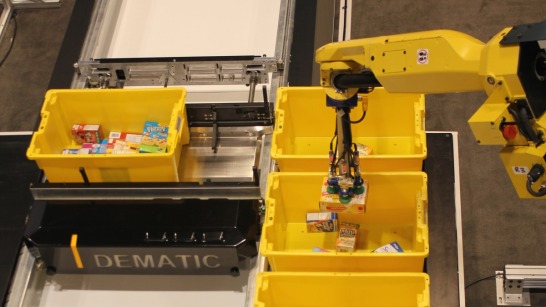Dark or smart?
“There is no contradiction between autonomy and collaborative systems,” stressed Professor Johannes Fottner, chair of Material Handling, Material Flow, and Logistics at the Technical University of Munich. Intelligent, cooperative robots might result in a more practical system than fully automated production systems. While a few exist, ‘dark factories’ – a concept where robots perform tasks needing no light nor humans to get the work done – they have never become widespread, and for good reason.
What exactly is autonomy in this context? When fed with all the tax laws, will robots eventually be able to fill out our tax returns, as Professor Kai Furmans from the Karlsruhe Institute of Technology would certainly like? “The problem is that the tax code is not without its contradictions,” he noted. And this is also the case with typical logistics processes. Even machine learning would not be able to easily resolve such contradictions, Furmans explained. However, machines can help us gather knowledge, process it and draw logical conclusions.
Humans and machines complement each other
Models where the strengths of humans and machines complement each other was a prominent topic featured in the discussions, presentations and general conversations of the 2-day event. While the fact that humans grow tired and are prone to error are generally cited as typical shortcomings when pitted against robots in warehouse processes, Fottner focused on a more obvious problem: “In my view, the greater disadvantage for us as humans is that we don’t have a USB or Wi-Fi portal.” In other words, humans need much more time to understand and process information than a machine powered by software. When it comes to picking and sorting goods, a human is still better at reaching into a box and identifying items than the latest robot available. Perhaps machines, ‘smart’ glasses and other innovative systems can help to overcome this aspect?
Various companies are already thinking about how they can benefit from autonomous systems. The German retail chain giant dm-drogerie stocks several thousand products and they all have to be placed on the right shelves every morning. No robot will be capable of doing that in the foreseeable future, but the management team would like to see store employees getting some help with the pre-sorting of products and, more importantly, the physically demanding task of transporting them to the shelves. Mail and logistics provider DHL, in contrast, is faced with the challenge of constantly increasing volume. According to the German-based company, international e-commerce is growing at an annual rate of 27 percent, which is much faster than domestic e-commerce. Intelligent autonomous trucks must be able to support order pickers as they move around. DHL is also testing automated vehicles for couriers and self-flying drones.
No standard technologies
Automated guided vehicles (AGVs) or robots which can grab, put away and put back items was a desire expressed repeatedly during the conference. A striking conundrum on display at the event was that though numerous companies are clearly looking for automated logistics solutions to give them the edge, many have very specific requirements. Standardized, packaged solutions do not seem to be the way of the future. Nor do they currently exist. In some cases, many large companies are simply deciding to build their own autonomous support systems for warehouses and factories. “We don’t really want to make robots because we are vehicle manufacturers,” admitted one conference participant, adding, “Still, we see the huge potential in logistics and we currently cannot find a manufacturer that can deliver what we need.”
The message for the intralogistics industry is clear: There is more than enough potential. Companies are taking a fresh look at their logistics processes and are ready to embrace change.
“There has never been a better time to work in the supply chain segment than today,” expressed a supply chain manager with a major global player. “ Previously, our area was never taken seriously.” However, that is all changing with companies having a load of options to select from and experiment with – autonomous vehicles, drones, and artificial intelligence – the potential is very big.


/mpm_smurfit_kappa_keyvisual_image_546x307.jpg)